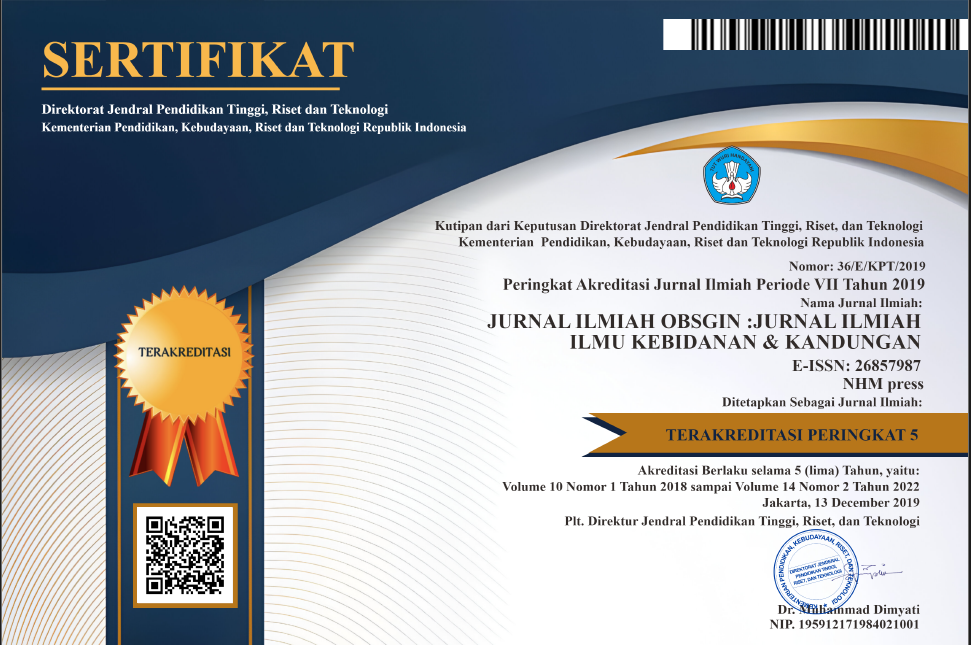Hubungan Usia dan Aktivitas dengan Kenaikan Berat Badan Akseptor KB Suntik 3 Bulan Di TPMB Andrini Desa Selok Awar-Awar Kecamatan Pasirian
Abstract
Family planning is an action that helps married couples to avoid unwanted births, regulate birth spacing, and determine the number of children in the family by using hormonal or non-hormonal contraceptive methods. Combined contraceptives are available in pills and injections. While progestin contraceptives are found in injectable pills and implants. All types of contraception have advantages and disadvantages. The main drawbacks of injectable contraceptives are menstrual disorders, namely spotting, amenorrhea and menorrhagia, delayed return of fertility after discontinuation of use and weight gain. The effect of weight gain is because progestin stimulates the appetite control center in the hypothalamus which causes the hormone progesterone to facilitate the conversion of carbohydrates and sugar into fat, so that fat under the skin increases. In addition, factors that can trigger weight gain are age, activity patterns, nutritional patterns, psychological factors, and body metabolism.
The purpose of this study was to determine the relationship between age and activity with weight gain of 3-month injection family planning acceptors. This study uses an analytic observational research design with a Cohort approach. The population in this study is the number of 3 month injection family planning acceptors who visited TPMB as many as 50 acceptors and the number of samples used was 30 acceptors with quota sampling technique, and statistical tests using Spearman rank correlation.
The results showed that respondents aged 20-35 years who experienced weight gain were 12 respondents with the results of statistical tests with Spearman rank obtained p-value = 0.782 > 0.05 and respondents with light activities who experienced weight gain were 14 respondents with the results of statistical tests with spearman rank obtained p-value = 0.488> 0.05. So it can be concluded that there is no relationship between age and activity with weight gain of 3-month injection family planning acceptors at TPMB Andrini, Selok Awar-awar Village, Pasirian District, Lumajang Regency. Suggestions for acceptors are to really understand how big the side effects of using 3-month injectable contraceptives are.
References
BKKBN. 2019. Sosialisasi Tentang Keluarga Berencana . https://kampungkb.bkkbn.go.id/kampung/12940/intervensi/111032/sosialisasi-tentang-keluarga-berencana. Diakses 22 mei 2022
Casey, Frances E. 2020. Contraception : Practice Essentials, Overview, Periodic Abstinence [Internet]. medscape. p. 1. Available from: https://emedicine.medscape.com/article/258507 overview?src=mbl_msp_android&ref=share
Gustikawati, D.A. 2014. Faktor Pendukung dan Penghambat Istri PUS dalam Penggunaan Alat Kontrasepsi Implant di Puskesmas 1 Denpasar Utara. Publikasi Penelitian. Denpasar: Jurusan Kesehatan Masyarakat Universitas Udayana..
Hartanto, H. 2015. Keluarga Berencana dan Kontrasepsi. Jakarta : Pustaka Sinar Harapan.
Hasyim, Ahmad Azmi. 2017. Hubungan pemakaian kontrasepsi Suntik DMPA terhadap kenaikan berat badan Di Desa Dalu 10B, Tanjung Morawa. Skripsi. Tidak diterbitkan, Fakultas Kedokteran Universitas Sumatera Utara, Medan.
Hidayat. 2014. Kerangka Kerja Penelitian. Jakarta : Rineka Cipta
Irsyad Aufa, Rafleseptiawan. 2021. Hubungan Aktivitas Fisik Dengan Kenaikan Berat Badan Pada Mahasiswa Fk Umsu Angkatan 2018 Di Masa Pandemi. Tidak diterbitkan, Fakultas Kedokteran Universitas Muhammadiyah Sumatera Utara Medan
Kartiyem. 2021. Hubungan Penggunaan KB Suntik Progestin dengan Peningkatan Berat Badan Akseptor KB di Praktik Mandiri Bidan Kartiyem, Pengasih, Kulon Progo Tahun 2020. Skripsi. Tidak diterbitkan, Jurusan Kebidanan Politeknik Kesehatan Kementerian Kesehatan Yogyakarta.
Kho, Dickson. 2020. Analisis Regresi Linear Sederhana (Simple Linear Regression). https://teknikelektronika.com/analisis-regresi-linear-sederhana-simple-linear-regression. Diakses 22 juni 2022
Koes I. 2014. Anatomi Dan fisiologi. Bandung : Alfabeta
Masturoh, Imas., Anggita T, Nauri. 2018. Metodologi Penelitian Kesehatan. Kementerian Kesehatan Republik Indonesia: Pusat Pendidikan Sumber Daya Manusia Kesehatan
Mulyani Ns. 2013. Keluarga Berencana dan Alat Kontrasepsi. Yogyakarta: Nuha Medika.
Nursalam. 2013. Hipotesis Penelitian. Jakarta : Rineka Cipta
Nursalam. 2015. Metodologi Penelitian Ilmu Keperawatan. Jakarta : Salemba Medika.
Penggunaan KB Suntik dan Non Kontrasepsi dengan Siklus Menstruasi pada Wanita Usia Subur di Wilayah Kerja Puskesmas Baturaden II. Skripsi. Tidak diterbitkan, Fakultas Ilmu Kesehatan UMP.
Proverawati A, Misaroh S. 2017. Panduan memilih kontrasepsi. Yogyakarta: Nuha Medika.
Rismawati, S. 2012. UNMEET NEED : Tantangan Program Keluarga Berencana dalam menghadapi Ledakan Penduduk Tahun 2030. Publikasi Penelitian. Bandung : Fakultas Kedokteran UNPAD
Setiawan, Heri. 2022. Mengenal Aktivitas Fisik Macam-Macam dan Manfaatnya Bagi Tubuh. https://tirto.id/mengenal-aktivitas-fisik-macam-macam-dan-manfaatnya-bagi-tubuh-gngr. Diakses 22 mei 2022
Sherwood L. 2014. Fisiologi Manusia : Dari Sel ke Sistem (Introduction to Human Physiology). Penerbit Buku Kedokt EGC.
Statistika, Admin. 2021. Mengenal Lebih Jauh Tentang Uji Korelasi Rank Spearman – Jasa Olah Data Statistika Nusagama. https://gamastatistika.com/2021/06/03/mengenal-lebih-jauh-tentang-uji-korelasi-rank-spearman/. Diakses 23 juni 2022
Stewart M, Black K. 2015. Choosing A Combined Oral Contraceptive Pill. Aust Prescr. 2015. ; emergency contraception. Linacre Quarterly.












